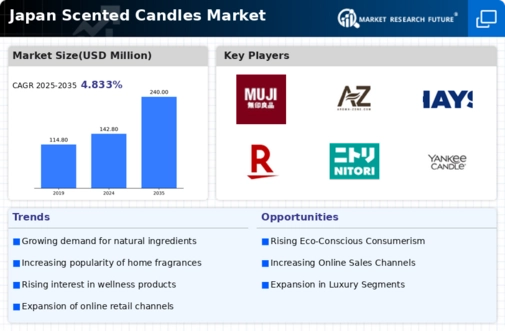The scented candles market in Japan exhibits a dynamic competitive landscape characterized by a blend of established brands and emerging players. Key growth drivers include an increasing consumer preference for home fragrances, heightened awareness of wellness, and a growing trend towards premiumization. Major companies such as Yankee Candle (US), Bath & Body Works (US), and Diptyque (FR) are strategically positioned to leverage these trends. Yankee Candle (US) focuses on innovation in scent offerings and sustainable practices, while Bath & Body Works (US) emphasizes regional expansion and digital transformation to enhance customer engagement. Diptyque (FR), known for its luxury positioning, continues to refine its product lines to cater to affluent consumers, collectively shaping a competitive environment that prioritizes quality and brand loyalty.
In terms of business tactics, companies are increasingly localizing manufacturing to reduce lead times and optimize supply chains. The market structure appears moderately fragmented, with a mix of large multinational corporations and smaller niche brands. This fragmentation allows for diverse consumer choices but also intensifies competition among key players, who must continuously innovate to maintain market share.
In October 2025, Yankee Candle (US) announced the launch of a new line of eco-friendly candles made from 100% natural wax, reflecting a growing consumer demand for sustainable products. This strategic move not only aligns with global sustainability trends but also positions the brand as a leader in environmentally conscious offerings, potentially attracting a broader customer base.
In September 2025, Bath & Body Works (US) unveiled a new digital marketing campaign aimed at enhancing online sales, which have become increasingly vital in the current retail landscape. This initiative underscores the importance of digital transformation in reaching consumers effectively, particularly in a market where e-commerce continues to grow. By investing in digital strategies, the company aims to solidify its market presence and drive sales growth.
In August 2025, Diptyque (FR) expanded its product range by introducing a limited-edition collection inspired by Japanese culture, which reflects a strategic effort to resonate with local consumers. This move not only enhances brand relevance but also demonstrates the company's commitment to cultural sensitivity and market adaptation, potentially increasing its appeal in the Japanese market.
As of November 2025, current competitive trends in the scented candles market are increasingly defined by digitalization, sustainability, and the integration of AI technologies. Strategic alliances among companies are shaping the landscape, fostering innovation and collaboration. The shift from price-based competition to a focus on innovation, technology, and supply chain reliability is evident, suggesting that future differentiation will hinge on the ability to adapt to consumer preferences and market demands.

















Leave a Comment